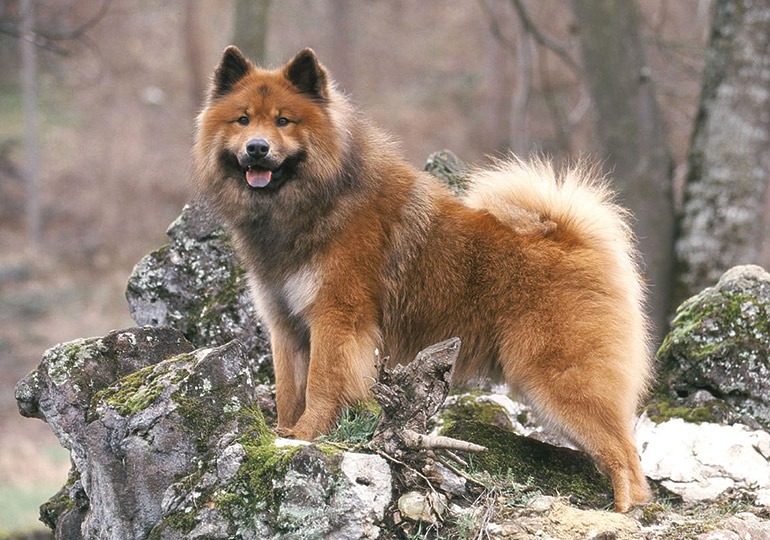Eurasier
Breed Details
Size:
Exercise Requirements:
Grooming Requirements:
18-32 Kg (Approx)
12-16 years (Approx)

Appearance
The Eurasier is a balanced, well-constructed, medium-sized Spitz type dog with prick ears. It comes in different colors: fawn, red, wolf-grey, solid black, and black and tan. All color combinations are allowed, except for pure white, white patches, and liver color. Fédération Cynologique Internationale (FCI) standards call for the Eurasier to have a thick undercoat and medium-long, loosely lying guard hair all over the body, with a short coat on the muzzle, face, ears, and front legs. The tail and the back of the front legs (feathers) and hind legs (breeches) should be covered with long hair. The coat on the Eurasier's neck should be slightly longer than on the body, but not forming a mane. The breed may have a pink, blue-black or spotted tongue.
All colours and colour combinations are permitted with the exception of pure white, white patches or liver colour
History
Eurasiers originated in Germany in 1960, when the founder, Julius Wipfel, set out together with Charlotte Baldamus and a small group of enthusiasts to create a breed with the best qualities of the Chow Chow and the Wolfspitz. The initial combination of the breeds resulted in what was first called "Wolf-Chow" and then, twelve years later, after crossing with a Samoyed, was renamed "[Eurasier]" (Eurasian) and recognized by the FCI in 1973. Nobel Laureate Konrad Lorenz obtained a Eurasier puppy from Charlotte Baldamus, Nanette vom Jaegerhof, whom he called "Babett". He thought her character was the best he had ever known in a dog.
Today, unethical breeders sometimes try to pass off a Keeshond/Chow Chow mix as a Eurasier. While they are genetically similar, these mixes cannot be classified as Eurasiers.
Eurasiers are still a comparably young breed. The three Eurasier Clubs are in the German Kennel Club VDH / FCI —EKW, KZG, and ZG: therefore strongly direct and supervise breeding in Germany.
A group of very dedicated Eurasier Clubs have joined together in the International Federation for Eurasier Breeding (IFEZ) in the FCI. Eurasier puppies bred according to these sound IFEZ guidelines receive an IFEZ certificate.
Temperament
It is widely known as a wonderful companion that maintains its own personality, has a dignified reserve to strangers, a strong bond to its family and that is relatively easy to train.
Eurasiers are calm, even-tempered dogs. They are watchful and alert, yet reserved towards strangers without being timid or aggressive. Eurasiers form a strong link to their families. For the full development of these qualities, the Eurasier needs constant close contact with its family, combined with understanding, yet consistent, training. They are extremely sensitive to harsh words or discipline and respond best to soft reprimand. The Eurasier is a combination of the best qualities of the Chow Chow, the Keeshond, and the Samoyed (dog), resulting in a dignified, intelligent breed.
Eurasiers were bred as companion dogs; as such they do poorly in a kennel environment such as those commonly used for institutionally trained service dogs, nor are they well suited for the social stresses of working as a sled or guard dog.
Training should always be done through family members, not through strangers or handlers. Eurasiers should never be restricted to only a yard, kennel, crate, or chained up. They would pine and become depressed. Within these limitations, Eurasiers can work very well as therapy dogs. This breed enjoys all kinds of activities, especially if the activities involve their family.
Eurasiers are calm and quiet indoors, outdoors they are lively and enjoy action. Eurasiers rarely bark but if they do, they usually have a good reason.
Care/Grooming
Eurasiers are generally healthy dogs, though a small gene pool in the breed's early years has led to some hereditary diseases being seen occasionally. Known issues include hip dysplasia, luxating patella, and hypothyroidism, as well as eyelid and lash disorders such as distichiae, entropion, and ectropion.
Eurasiers need a once-a-week to bi-weekly thorough combing/brushing with body checks for burrs or pests; a cleaning of their eyes, ears and a check of their pads; and occasional nail clippings, if needed (especially their dewclaws).They have little body odor and require infrequent bathing. Typically, Eurasiers shed their entire undercoat once or twice a year for a period of about 3 weeks. During undercoat shedding periods, daily combings/brushings are required.
Breeders
Currently no Breeders in SA for this Breed

